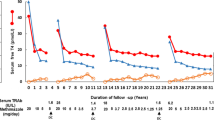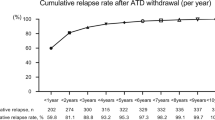Abstract
TSH has been incriminated in Graves’ disease for increasing the production of antibodies against TSH receptor (TRAb). It has been, therefore, suggested that T4 administration after successful antithyroid drug (ATD) treatment may indirectly decrease the production of TRAb and, therefore, the frequency of recurrence of hyperthyroidism. To study the role of T4 and T3 on the recurrence rate of Graves’ disease 108 patients with Graves’ disease (22 males, age: 49.8±14.3 yr, mean±SD, and 86 females, age: 41.7±12 yr) were followed-up for 24 months after successful treatment with ATD (carbimazole). During the follow-up period, patients daily received either 100 μg T4 or 25 μg T3 or placebo after random and double-blinded assignment into three groups. They were evaluated trimonthly up to 12 months and at 24 months. Plasma TRAb levels were measured at the beginning and at 12 months. At 12 months of the follow-up period, 14 out of 33 (42.4%), 6 out of 38 (15.8%), and 9 out of 37 (24.3%) patients receiving T4, T3 and placebo, respectively, recurred. Recurrence rate of T4-treated patients was statistically higher than that of the T3-treated patients or controls (p<0.05). At the beginning of the follow-up period patients who were going to recur had significantly higher TRAb levels and goiter weight than patients who were not (p<0.05). At 24 months of the follow-up period, from the patients who did not drop out of the study, none out of 11 (0%), 2 out of 19 (10.5%) and 1 out of 12 (8.3%) receiving T4, T3 and placebo, respectively, recurred. We conclude that T4 administration after successful ATD treatment of Graves’ disease is associated with increased recurrence of hyperthyroidism as compared to the T3 or placebo administration. High TRAb levels and goiter weight at the end of ATD treatment may hint at recurrence.
Similar content being viewed by others
References
Astwood E.B. Treatment of hyperthyroidism with thiourea and thiouracil. J.A.M.A. 1943, 122: 78–81.
Wartofsky L., Glinoer D., Solomon B, et al. Differences and similarities in the diagnosis and treatment of Graves’ disease in Europe, Japan and the United States. Thyroid 1991, 1: 129–135.
Hedley A.J., Young R.E., Jones S.J., Alexander W.D., Bewsher P.D., Scottish Automated Follow-Up Register Group. Antithyroid drugs in the treatment of hyperthyroidism of Graves’ disease: long-term follow-up of 434 patients. Clin. Endocrinol. (Oxf.) 1989, 31: 209–218.
Schleusener H., Schwander J., Fischer C., et al. Prospective multicentre study on the prediction of relapse after antithyroid drug treatment in patients with Graves’ disease. Acta Endocrinol. (Copenh.) 1989, 120: 689–701.
Törring O., Tallstedt L., Wallin G., et al. Graves’ hyperthyroidism: treatment with antithyroid drugs, surgery, or radioiodine — a prospective randomized study. J. Clin. Endocrinol. Metab. 1996, 81: 2986–2993.
Mastorakos G., Doufas A.G., Mantzos J., Koutras D.A. Long-term follow-up of 202 patients with Graves’ disease treated medically. Thyroidology 1997, 9: 71–80.
Hashizume K., DeGroot L.J. Release of thyrotropin receptor from thyroid plasma membranes: effect of hydrocortisone, propanolol, and adenosine 3′,5′-monophosphate. Endocrinology 1980, 106: 1463–1468.
Hashizume K., Ichikawa K., Sakurai K., et al. Administration of thyroxine in treated Graves’ disease: effects on the level of antibodies to thyroid-stimulating hormone receptors and on the risk of recurrence of hyperthyroidism. N. Engl. J. Med. 1991, 324: 947–953.
Hashizume K., Ichikawa K., Nishii Y., et al. Effects of administration of thyroxine on the risk of postpartum recurrence of hyperthyroid Graves’ disease. J. Clin. Endocrinol. Metab. 1992, 75: 6–10.
Doufas A.G., Mastorakos G., Mantzos J., Koutras D.A. Recurrence of Graves’ disease is independent of thyroxine administration after medical therapy. Thyroid 1995, 5 (Suppl. 1): S70.
McIver B., Rae P., Beckett G., Wilkinson E., Gold A., Toft A. Lack of effect of thyroxine in patients with Graves’ hyperthyroidism who are treated with an antithyroid drug. N. Engl. J. Med. 1996, 334: 220–224.
Pfeilschifter J., Ziegler R. Suppression of serum thyrotropin with thyroxine in patients with Graves’ disease: effects on recurrence of hyperthyroidism and thyroid volume. Eur. J. Endocrinol. 1997, 136: 81–86.
Rittmaster R.S., Abbot E.C., Douglas R., et al. Effect of methimazole, with or without L-thyroxine, on remission rates in Graves’ disease. J. Clin. Endocrinol. Metab. 1998, 83: 814–818.
Mantzos J.D., Yialouris P.P. A simple and reproducible method for the estimation of triiodothyronine uptake (thyroxine binding index) using a new adsorbent. Clin. Biochem. 1982, 15: 76–79.
Statistica software for Windows. Copyright © 1984-1994 by StatSoft, Inc., Tulsa, Oklahoma.
Doufas A.G., Mastorakos G., Chatziioannou S., et al. The predominant form of non-toxic goiter in Greece is now autoimmune thyroiditis. Eur. J. Endocrinol. 1999, 140: 505–511.
Lucas A., Salinas I., Rius F., et al. Medical therapy of Graves disease: does thyroxine prevent recurrence of hyperthyroidism? J. Clin. Endocrinol. Metab. 1997, 82: 2410–2413.
Garcia-Mayor R.V., Paramo C., Luna Cano R., Perez Mendez L.F., Galofre J.C., Andrade A. Antithyroid drug and Graves’ hyperthyroidism. Significance of treatment duration and TRAb determination on lasting remission. J Endocrinol. Invest. 1992, 15: 815–820.
Vitti P., Rago T., Chiovato L., et al. Clinical features of patients with Graves’ disease undergoing remission after antithyroid drug treatment. Thyroid 1997, 7: 369–375.
Feldt-Rasmussen U., Schleusener H., Carayon P. Metaanalysis evaluation of the impact of thyrotropin receptor antibodies on long term remission after medical therapy of Graves’ disease. J. Clin. Endocrinol. Metab. 1994, 78: 98–102.
Rink T., Holle L.H., Schroth H.J., Garth H. Individual outcome monitoring of TSH receptor antibody level for predicting the prognosis of Graves’ disease. Nuklearmedizin 1998, 37: 90–94.
Keck F.S., Loos U. Peripheral autoregulation of thyromimetic activity in man. Horm. Metab. Res. 1988, 20: 110–114.
Glinoer D., de Nayer P., Bex M. Effects of l-thyroxine administration, TSH-receptor antibodies and smoking on the risk of recurrence in Graves’ hyperthyroidism treated with antithyroid drugs: a double-blind prospective randomized study. Eur. J. Endocrinol. 2001, 144: 475–483.
Bartalena L. Smoking and Graves’ disease. J. Endocrinol. Invest. 2002, 25: 402.
Author information
Authors and Affiliations
Corresponding author
Rights and permissions
About this article
Cite this article
Mastorakos, G., Doufas, A.G., Mantzos, E. et al. T4 but not T3 administration is associated with increased recurrence of Graves’ disease after successful medical therapy. J Endocrinol Invest 26, 979–984 (2003). https://doi.org/10.1007/BF03348195
Accepted:
Published:
Issue Date:
DOI: https://doi.org/10.1007/BF03348195




